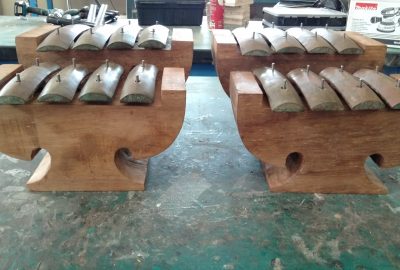In 2019, we restored and reconstructed a very unusal Angklung set from Lombok we have called ‘Semara Kirang’ because of its tuning, where it has four sweet tones with the lowest one missing. These types of sets that included squat gangsa called gangsa jongkok, cungklik (a xylophone in two octaves with slab bamboo keys affixed with nails to a box resonator), large cymbals with a lower pitched kempur when compared to most other Angklung in Bali, were still found in the Karangasem region less than a century ago.
The original instruments we acquired in 2017 were two squat gangsa in the kantilan range and two squat gangsa in the swir range as well as four reong in the kantilan range. One of the reong was badly damaged, and this required particular care and a lot of time to restore.

These instruments were also very out of tune, presumably after decades of lack of use, so Vaughan reconstructed the scale based on general tuning concepts he had heard in Lombok where the tones were sometimes arranged in the more unusual order of ndong, ndeng, ndung, ndang rather than the typical ndeng, ndung, ndang, nding.
Watch a video of our set:


















